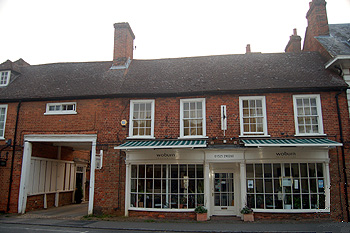13 Bedford Street Woburn

13 Bedford Street May 2012
13 Bedford Street was listed by the former Ministry of Works in January 1961 as Grade II, of special interest. The house was built in the late 18th century in brick “probably re-fronting an earlier structure”. The roof comprises 20th century tiles. The property has two storeys.
The Rating and Valuation Act 1925 specified that every building and piece of land in the country was to be assessed to determine its rateable value. Woburn, like much of the county was valued in 1927 and the valuer visiting 13 Bedford Street [DV1/C137/100] found that, like most of the town, it was owned by the Duke of Bedford’s London and Devon Estates Company.
The occupier was Mrs. King, a baker, whose rent was £20 per annum. Her ground floor accommodation comprised: a shop measuring 10 feet 3 inches by 15 feet; a tea room measuring 14 feet by 9 feet 3 inches and a kitchen measuring 15 feet by 12 feet. A bakehouse with a loft over measured 15 feet square with an oven measuring 6 feet 6 inches by 8 feet 6 inches. First floor accommodation comprised: a tea room measuring 15 feet by 12 feet 3 inches and two bedrooms measuring, respectively, 15 feet 6 inches by 11 feet 6 inches and 13 feet 6 inches by 11 feet 6 inches. There was also an attic bedroom measuring 15 feet 6 inches by 12 feet and a cellar.
Outside stood a W. C. and washhouse, a store barn, standing for two cows and an open shed. The valuer commented: “Rambling, was part of Goat Inn. Bakehouse low intentionally, little used”. Directories of Bedfordshire were published every few years between the early 19th and mid 20th centuries. Mrs. King was probably the widow of Charles King who is listed as a baker in Bedford Street in directories of 1924, 1920, 1914, 1910, 1906, 1903, 1898, 1894, 1890 and 1885. He overlapped with another baker in Bedford Street, Robert James Lilley, who seems to have had his premises at 5 Bedford Street. Also overlapping with Lilley was John Beard who is mentioned in directories of 1847, 1852, 1854, 1862, 1869 and 1877 as a baker in Bedford Street. It seems a possibility that he was King’s predecessor and possibly in the same property as a baker would naturally look for a premises already adapted to the trade with ovens and other necessary accommodation.
John Beard seems to have been preceded by John Crick who was listed as a baker and confectioner in Bedford Street in 1839. He is also listed in a directory of 1823. This was two years and eighteen years, respectively, before the Goat Inn closed in 1841 but would not necessarily present difficulties as the Goat may have been the part of the property closest to the arch between 13 and 14, which building is also later recorded as having been occupied by the Goat. This would leave the right hand portion of today’s 13 Bedford Street as the bakery. After Mrs. King gave up the trade the last two directories for the county (1936 and 1940) list Mrs. Doris Edith Watson as a fruiterer at the address.
In 1977 planning permission was applied for to convert the first floor of The Woburn Wine Lodge (as the premises was then called) to be a restaurant [PL/P/MB77/44LB]. In the early 1990s the property was converted into a brasserie [PCWoburn18/2/4] by the name of Nicholls. At the time of writing [2013] the property is called Woburn Brasserie.
The Bedfordshire Historic Environment Record [HER] contains information on the county’s historic buildings and landscapes and summaries of each entry can now be found online as part of the Heritage Gateway website. Excavations on the premises [HER 18268] uncovered evidence of a Roman settlement dating from the 1st to 3rd centuries AD, and evidence of industrial pottery production from the late 1st to early 2nd centuries.